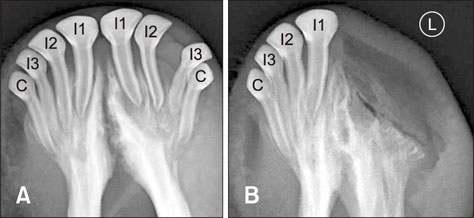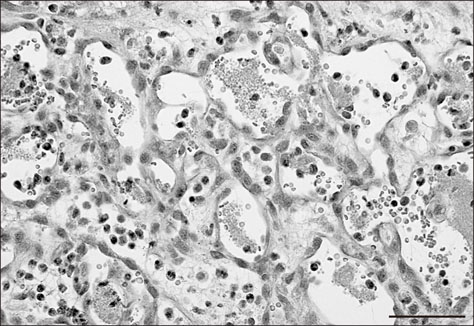J Vet Sci.
2018 Jul;19(4):582-584. 10.4142/jvs.2018.19.4.582.
Unilateral rostral mandibulectomy for gingival vascular hamartoma in two calves
- Affiliations
-
- 1Department of Veterinary Clinical Medicine, School of Veterinary Medicine, Tottori University, Tottori 680-8553, Japan. tsuka@muses.tottori-u.ac.jp
- 2Shimane Prefectural Federation Agricultural Mutual Aid Association, Shimane 690-0887, Japan.
- 3Tottori Prefectural Federation Agricultural Mutual Aid Association, Tottori 689-2202, Japan.
- KMID: 2417576
- DOI: http://doi.org/10.4142/jvs.2018.19.4.582
Abstract
- A 2-month-old female Holstein calf and a 5-month-old female Japanese black calf presented with gingival vascular hamartoma located in the interdental space between the second and third mandibular incisors in the right and left mandibles, respectively. On radiographic or computed tomographic images, osteolytic changes appeared within the mandibular bones adjacent to the masses. The masses were removed along with affected mandibular bone by using unilateral rostral mandibulectomy. After surgery, both cases exhibited a normal appetite and grew normally, with no cosmetic changes or recurrences. Unilateral rostral mandibulectomy can be applied for invasive gingival vascular hamartomas associated with osteolytic changes.
MeSH Terms
Figure
Reference
-
1. Aspinall V, Cappello M. Comparative anatomy and physiology. In : Aspinall V, Cappello M, editors. Introduction to Veterinary Anatomy and Physiology Textbook. 3rd ed. London: Elsevier Health Sciences;2015. p. 211–244.2. Mendez-Angulo JL, Tatarniuk DM, Ruiz I, Ernst N. Extensive rostral mandibulectomy for treatment of ameloblastoma in a horse. Vet Surg. 2014; 43:222–226.
Article3. Mohammadi GR, Maleki M, Sardari K. Gingival vascular hamartoma in a young Holstein calf. Comp Clin Pathol. 2007; 16:73–75.
Article4. Rösti L, Lauper J, Merhof K, Gorgas D, Ross S, Grest P, Welle MM. [Blood vessel anomalities in the oral cavity of two calves]. Schweiz Arch Tierheilkd. 2013; 155:627–632. German.5. Sheahan BJ, Donnelly WJ. Vascular hamartomas in the gingiva of two calves. Vet Pathol. 1981; 18:562–564.
Article6. Taney KG, Dubielzig RR, Trotter TS, Smith MM. Bilateral maxillary periodontal ligament hamartoma in a dog. J Vet Dent. 2005; 22:91–95.
Article7. Tetens J, Ross MW, Sweeney RW. Rostral mandibulectomy for treatment of an ameloblastic fibro-odontoma in a cow. J Am Vet Med Assoc. 1995; 207:1616–1617.8. Verstraete FJ. Mandibulectomy and maxillectomy. Vet Clin North Am Small Anim Pract. 2005; 35:1009–1039. viii
Article9. Wilson RB. Gingival vascular hamartoma in three calves. J Vet Diagn Invest. 1990; 2:338–339.
Article10. Yeruham I, Abramovitch I, Perl S. Gingival vascular hamartoma in two calves. Aust Vet J. 2004; 82:152–153.
Article





